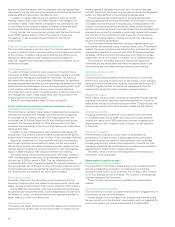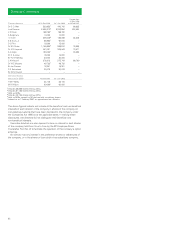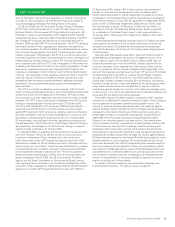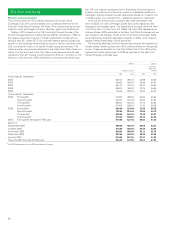BP 2006 Annual Report Download - page 81
Download and view the complete annual report
Please find page 81 of the 2006 BP annual report below. You can navigate through the pages in the report by either clicking on the pages listed below, or by using the keyword search tool below to find specific information within the annual report.
BP Annual Report and Accounts 2006 79
Board committees
The governance process policy allocates the tasks of monitoring executive
actions and assessing performance to certain board committees. These
tasks prescribe the authority and role of the board committees.
Reports for each of the committees for 2006 follow. In common with
the board, each committee has access to independent advice and counsel
as required and each is supported by the company secretary’s office,
which is demonstrably independent of the executive management of
the group.
Audit committee report
Membership and meeting schedule
The audit committee consists solely of independent non-executive
directors. Its membership is selected to provide a broad set of
financial, international and commercial expertise appropriate to fulfil
the committee’s duties.
Members of the audit committee include Sir Ian Prosser (chairman),
Mr D J Flint, Mr E B Davis, Jr and Mr J H Bryan. During 2006, Mr M H
Wilson and Mr H M P Miles retired from the committee and Sir William
Castell joined as a new member. The company secretary’s office ensures
new committee members receive briefings on the committee’s tasks and
process before taking up their roles.
The board has determined that Mr Flint possesses the financial and
audit committee experience as defined by the Combined Code guidance
and the US Securities and Exchange Commission and has nominated him
as the audit committee’s financial expert.
At the request of the audit committee chairman, each meeting is
attended by the lead partner of the external auditors (Ernst & Young), the
BP general auditor (head of internal audit), the group chief financial officer,
the chief accounting officer and the group controller.
The audit committee met 12 times during 2006.
Role of audit committee
The tasks of the audit committee include gaining assurance on the
financial processes of the group and the integrity of its reports and
accounts. On behalf of the board, it monitors observance of the executive
limitations policy relating to financial matters. The committee reviews the
management of financial risks and the internal controls designed to
address them.
The committee believes that it meets each of the tasks that are
outlined in the Combined Code as falling within the remit of an
audit committee.
Agenda and information
Central to the operation of the audit committee is the meeting agenda.
Forward agendas are set at the start of each year to determine a high-
level work programme for the committee. Agendas are constructed from
regular items, including those that are required by regulation, and items
reflecting the board’s desire to review group risks. Between committee
meetings, the chairman reviews any issues that arise with the group
chief financial officer, the external auditors and the BP general auditor
and items may be added to the next committee meeting agenda
as appropriate.
The committee receives information on agenda items from both
internal and external sources, including the chief financial officer, the
internal auditor and BP’s external auditors. Presentations are made by
a wide cross-section of the group’s business and financial control
management. Where relevant to a particular business or functional
review, additional Ernst & Young audit staff attend and contribute.
In addition, the committee meets both the external auditors and BP
general auditor in private sessions where the executive management are
not present.
In common with other BP board committees, the audit committee can
access independent advice and counsel if it requires, on an unrestricted
basis. Further support is provided to the committee by the company
secretary’s office and, during 2006, external specialist legal and regulatory
advice was provided to the committee by Sullivan & Cromwell LLP.
The activities of the audit committee and any issues that have arisen
are reported back to the main board by the audit committee chairman
following each meeting.
Committee activities in 2006
Financial reports
During the year, the committee reviewed all annual and quarterly
financial reports before recommending their publication to the board.
The committee also examined the application of new financial
standards, critical accounting policies and judgements.
Internal controls and risk management
In the course of 2006, the audit committee reviewed reports on risks,
control and assurance for all the BP business segments (exploration
and production, refining and marketing and gas, power and renewables),
together with BP’s trading function. Reviews were also carried out on
BP’s long-term contractual commitments and the manner in which the
risks and control systems for these contracts were being managed.
Key regulatory issues are discussed throughout the year by the
committee as part of its standing agenda items. These include a quarterly
review of the company’s evaluation of its internal controls systems as
part of the requirement of Section 404 of the Sarbanes-Oxley Act. The
committee also examines the effectiveness of BP’s enterprise level
controls through the annual assessment undertaken by the company’s
internal audit function.
In addition to the recurring items on the agenda, the audit committee
considered a range of other specific topics during the year, including a
review of tax planning and provisions, an evaluation of the company’s
pension and post-retirement benefit assumptions and an assessment
of BP’s oil and gas reserves methodology.
Relationship with external auditors
As outlined above, the lead audit partner from Ernst & Young attends
all meetings of the audit committee at the request of the committee
chairman. Other audit partners are also invited to attend meetings to
participate in discussions relating to their areas of expertise, for example,
during business segment reviews.
During the year, the committee held two private meetings with the
external auditors without the presence of executive management, in order
to discuss any issues or concerns on the part of both the committee and
the auditors.
The performance of the external auditors is evaluated by the audit
committee each year. Central to this evaluation is scrutiny of the
external auditors’ independence, objectivity and viability. To maintain the
independence of the external auditors, the provision of non-audit services
is limited to tax and audit-related work that fall within specific categories.
This work is pre-approved by the audit committee and all non-audit
services are monitored quarterly. Fees paid to the external auditors
during the year for audit and other services were $73 million, of which
16% was for non-audit work (see Financial statements – Note 20 on
page 128). Non-audit services provided by Ernst & Young have been
significantly reduced over recent years but, reflecting regulatory and
reporting developments in the UK and US, audit fees have increased
substantially.
In addition to the restrictions on non-audit work, the objectivity and
independence of the external auditors are augmented by the rotation of
audit staff on a regular basis. A new lead audit partner is appointed every
five years and other senior audit staff are moved every seven years. It is
the policy of the company that no partners or senior staff connected with
the BP audit may transfer to BP.
After considering both the proposed fee structure and the audit
engagement terms for 2007, the audit committee has recommended
to the board that the reappointment of the auditors be proposed to
shareholders at the 2007 AGM.
Internal audit
BP’s internal audit function advises the committee on the company’s
identification and control of risk. The general auditor contributes widely
to the committee’s discussion of the company’s framework of internal
controls and the effectiveness of their application. The audit committee
agreed the work programme to be undertaken by internal audit during the
























